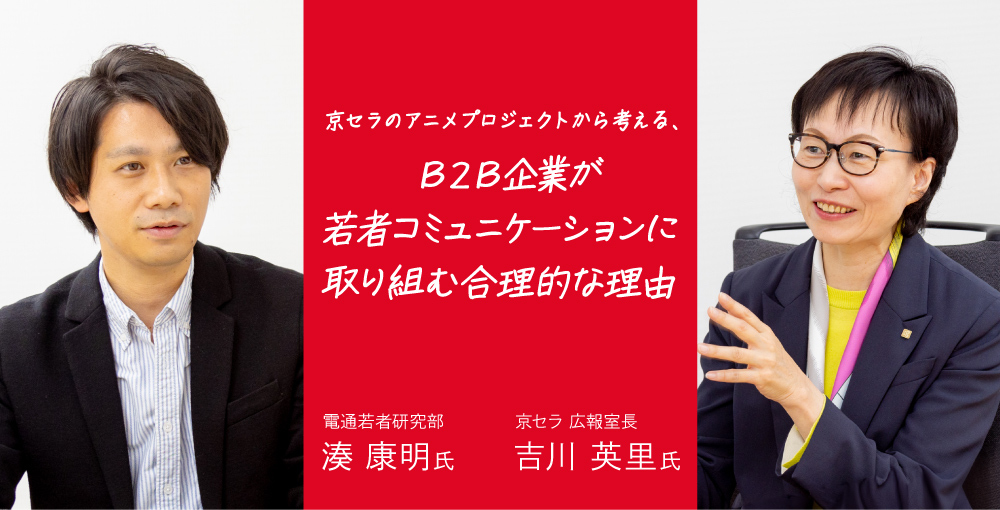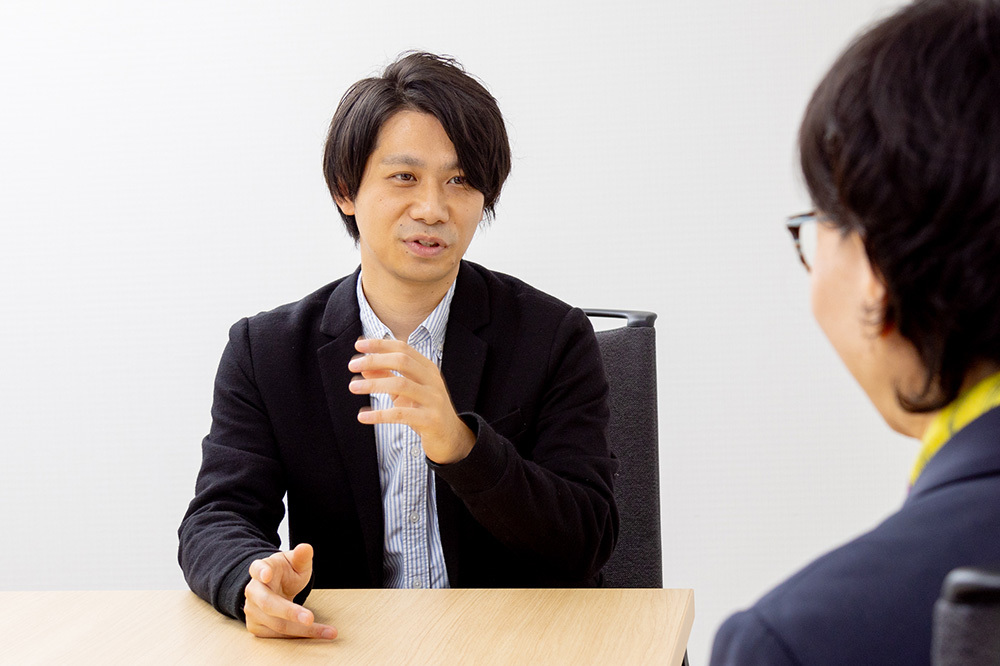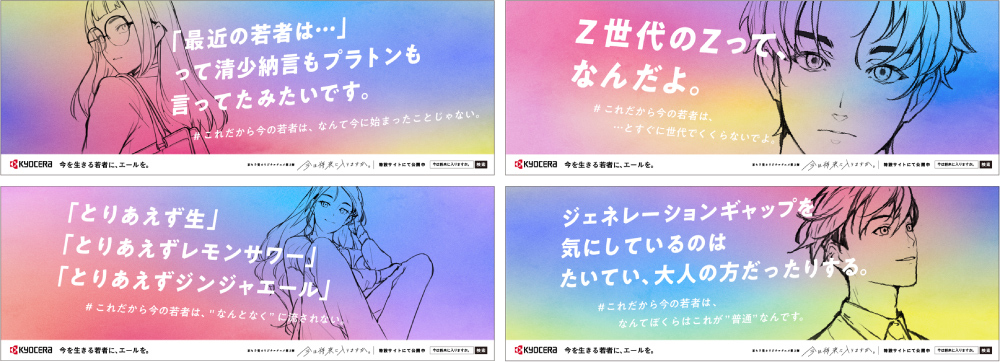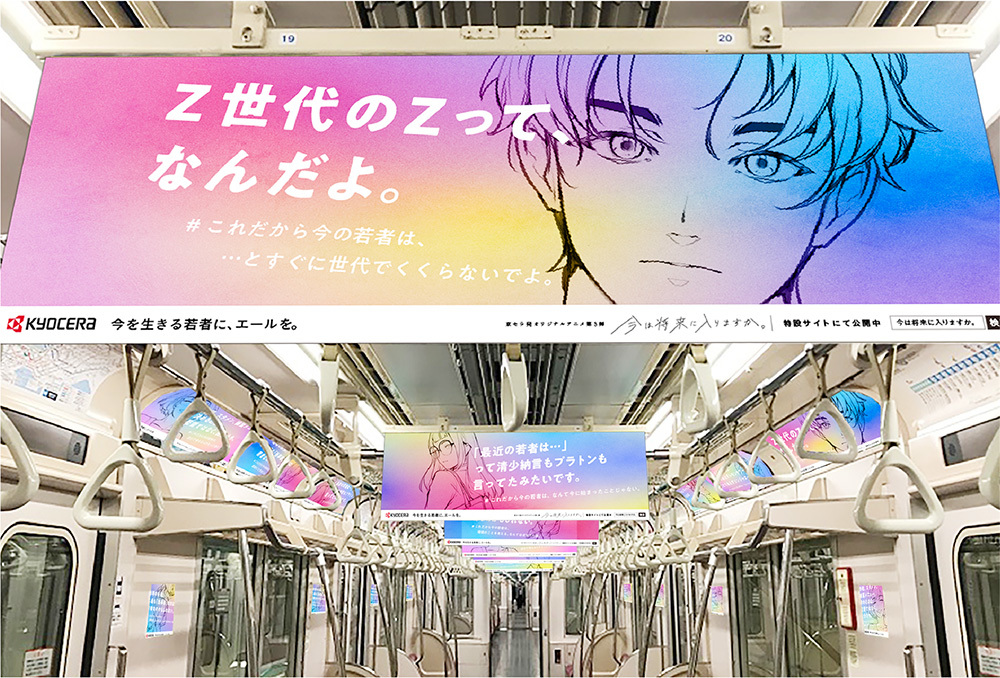
Kyocera launched the production of original anime featuring young protagonists in 2021. This project is one initiative addressing the challenge of "how a B2B company with a less visible face can communicate its philosophy while engaging with young people."
Three anime titles have been released since 2022 (see the Kyocera Original Anime website here ). The image of "Kyocera as a company that challenges new things" is gaining traction among young people, leading to a 1.4-fold increase in new graduate applications. This has also had a positive impact internally.
In this article, Yasuaki Minato from Dentsu Inc. Youth Research Department (hereafter Dentsu Wakamon), who supports the anime project, interviews Eri Yoshikawa, Head of Kyocera's Public Relations Office.
What are the challenges for Kyocera, a B2B company where its human face is hard to see?
Minato: Today, for Web Dentsu Inc. News readers, we'd like Ms. Yoshikawa to share the intent behind this project and the feedback it has received. First, please introduce yourself.
Yoshikawa: Since joining the company in 2001, I've been responsible for overseas PR and advertising. After becoming Head of the Public Relations Office, I now consider how to communicate the Kyocera brand not only internationally but also domestically. Furthermore, since 2019, I have also served as Head of the Diversity Promotion Office.
Minato: What kind of work does the Diversity Promotion Office focus on?
Yoshikawa: We strive to create a comfortable working environment where all employees embrace diversity and each individual can thrive. Recently, we've been focusing on bridging the generational gap between younger and veteran employees—what we call "Age Diversity."
Minato: Since launching the anime project in 2021, Dentsu Inc. has also been proposing concepts and collaborating on anime production. What was the original impetus for starting the anime project?
Yoshikawa: We felt a lack of communication with the younger generation. This is a common challenge not just for us, but for many B2B companies. Various brand surveys revealed that brand awareness among younger demographics was particularly low.
Minato: How does low awareness among younger generations impact overall management?
Yoshikawa: The young generation joining our company will shape the future of Kyocera. The fact that this generation doesn't know about Kyocera poses a significant risk when considering the company's future. Moreover, competition for young talent has intensified in recent years. As the PR department, we wanted to find a way to attract passionate young people who would help grow the company alongside us.
Minato: What do you think are the reasons for the low awareness among younger generations?
Yoshikawa: Fundamentally, B2B companies are hard for consumers to understand—what they do, what kind of company they are. Especially Kyocera: while our founding business was manufacturing ceramic components, we've diversified. Today, we provide components utilizing ceramic technology across various fields, plus solar power systems, communication terminals, medical products like artificial joints, and even kitchenware and jewelry manufacturing. This is a public relations nightmare... Even if we highlight specific products or services, it's extremely difficult to convey to consumers what kind of company Kyocera truly is.
Given this situation, the PR department has focused in recent years on communicating the management philosophy and core principles that underpin our products and services. We believe this approach makes Kyocera's identity more visible.
Minato: Why did you choose anime as a method to communicate with young people?
Yoshikawa: We considered various ideas, but the overwhelming sentiment from the younger generation in the PR department was, "We want to do anime." When asked why, they explained that anime has felt very familiar to them since childhood and is an effective means of conveying information. Moreover, they seemed to have a clear vision of the potential impact if we implemented such a strategy, so we decided to take a chance on anime production.
Choosing anime was also a way to differentiate ourselves from other B2B companies. While communication using anime isn't rare among other companies or government agencies, few B2B companies invest enough in anime to create a series.
Conveying Kyocera's Philosophy of "Altruism" Through Original Anime
Minato: Could you tell us about the content of the three anime works released so far?
Yoshikawa: We've released one anime per year since 2022. Each features a young protagonist on the verge of entering society. These characters grapple with the unique anxieties and uncertainties of youth, and the stories offer empathy and support for those struggles.
The first anime, "I Hate Being Asked to Describe Myself in One Word," conveyed the importance of acting on what moves your heart to a young person struggling with identity. The second anime, "My Hashtag Doesn't Look Good," encouraged young people concerned about others' opinions to pursue what they truly want to challenge themselves with. The third anime, "Does 'Now' Count Toward the Future?", tells young people feeling anxious about an uncertain future that accumulating what they can do now will open up their future.
Minato: What message do you want to convey through the entire anime series?
Yoshikawa: It's the "spirit of altruism" found in Kyocera's philosophy. In conducting business, Kyocera strives not just for its own profit, but for the happiness and benefit of various stakeholders, starting with its business partners. We wanted to convey that we have always cherished this "heart that cares for others."
In the anime, the phrase "for someone else" appears at key points in the story. It carries the message that even when facing anxieties about the future or inner conflicts, taking that first step yourself can ultimately benefit someone else.
Minato: Throughout the series, we were particular about the cast and music, weren't we?
Yoshikawa: We greatly relied on the production team from the Dentsu Group for this. We cast popular voice actors and put significant effort into the music. For example, in the third anime installment, we had suis from the popular band Yorushika perform the theme song. suis also participated in this work as a voice actor.
We've received numerous comments on social media like Instagram and X about the anime's creative aspects and the voice actors. The third installment, in particular, garnered an overwhelming number of comments about the music. The work was designed to resonate with fans of both the voice actors and the music, effectively connecting with supporters of each world.
Minato: The environment surrounding young people today is flooded with information, making it difficult for content to truly reach them. We believed that structuring an anime to incorporate various elements people enjoy would be effective for communicating with this audience. The initial aim was to spark interest through voice actors or artists, then have the story resonate emotionally, ultimately conveying Kyocera's underlying philosophy.
Yoshikawa: Minato-san also advised us, "It's better not to directly promote 'Kyocera is this kind of company'."
Minato: For example, if you want consumers to buy coffee, asking them directly, "Please buy coffee," will likely be rejected. At Dentsu Inc., we often share insights with our clients about the "tricks of information input and output."
For instance, in the input phase (the consumer's first contact), like with this anime production, we focus on topics and people young people are interested in. Then, in the output phase (the content), we present what Kyocera wants to convey. Structuring it this way makes it more easily accepted. Today, information is truly overwhelming, and people tend to ignore anything outside their interests. Therefore, communication must avoid being "all about us, all about us" and instead consciously adopt a stance of being close to consumers.
Yoshikawa: You're absolutely right. Through anime production, we learned how to "gain empathy without being pushy."
Minato: How was the response to the anime series?
Yoshikawa: From the very first anime, it was generally well-received by the younger generation within the company. On the other hand, some older generations questioned, "Does this really convey what Kyocera is about?" and it sparked some debate. However, as we continued producing more episodes, the public response grew significantly. Applications for new graduate recruitment increased by 1.4 times, and the number of prospective employees wanting to join us rose dramatically. Seeing these concrete, visible results helped the anime project gain understanding and acceptance within the company.
Minato: Kyocera's image is starting to come through, right? In surveys of young people at the project's start, many said they "didn't understand the company's character." But recent surveys show they now perceive us as a "company that takes on challenging endeavors" and a "dynamic company." We feel that "Kyocera's character" is gradually becoming visible to young people.
We launched train ads that positively reinterpreted the phrase "That's why today's youth..."
Minato: During the production of the third anime, your company and Dentsu Inc. Wakamon jointly conducted a "Generational Gap Survey," right? The results showed that 74.6% of adults (aged 35 and above) answered, "Actually, I think young people have amazing qualities." On the other hand, 68.3% of young people (under 35) answered, "Adults don't seem to like their own generation." How do you interpret these results?
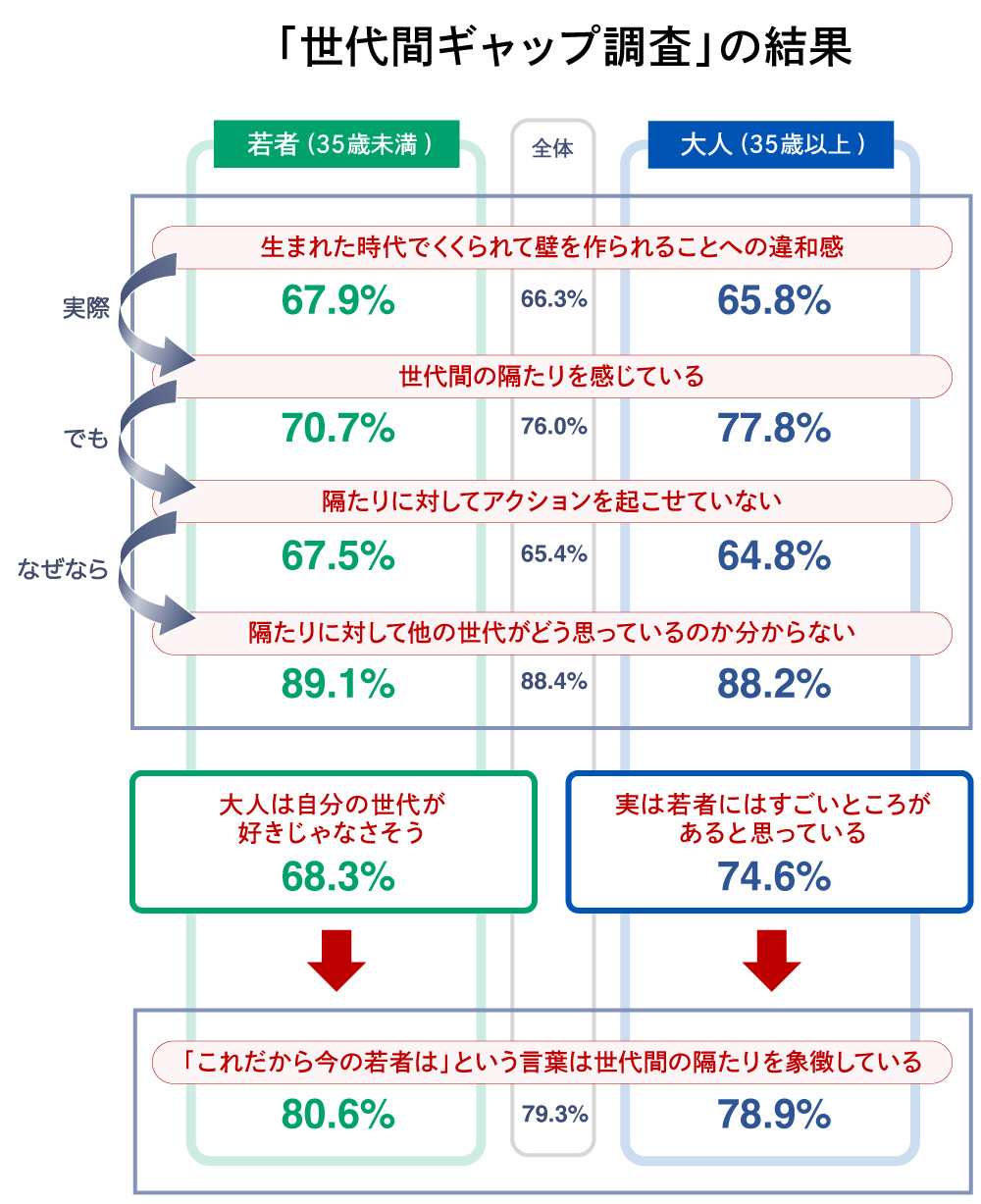
Survey Overview... Survey Period: December 2023, Sample Size: 1000 respondents, Survey Participants: Men and women aged 10s to 60s, Survey Method: Internet survey
Yoshikawa: Both young people and adults want to understand each other, but I feel a gap is emerging due to a lack of communication between them. If they could communicate more frankly, wouldn't that clear up misunderstandings and deepen their relationship?
Minato: Do you see this kind of disconnect between adults and young people within your company?
Yoshikawa: A common example is wanting to invite someone, "Let's grab a meal together. Let's go out for drinks," but hesitating because we worry, "Don't young people find our generation annoying?" Both young and old might be thinking, "Maybe they dislike us."
The "Age Diversity" I mentioned earlier is truly a major theme for our company. In the future, retirement ages will likely extend, increasing the senior workforce. In fact, nearly 90% of seniors at our company wish to continue working. The age of the older generation working alongside younger employees will keep rising. If there's a communication gap between generations then, it will be very problematic. When talking with other companies, "Age Diversity" is a theme everyone shows high interest in.
Minato: Based on the survey results, we implemented a train jacking campaign that also served as PR for the third anime installment. We created train interior ads using the phrase "That's why today's youth..." as a symbol of the gap between young people and adults.
Yoshikawa: It was impressive how the phrase "That's why today's youth..."—often used negatively—was reinterpreted positively. Copy that encourages young people, sharing the same worldview as the anime, was developed. Underpinning this train jack campaign is also Kyocera's philosophy of "altruism." We infused this campaign with the hope that a company voicing its desire to "stand alongside young people" would serve as encouragement for them, spark awareness among other generations, and become a catalyst for bridging the generation gap.
To bridge the generation gap, we also need perspectives that transcend categories.
Minato: How do you plan to communicate with young people going forward?
Yoshikawa: Both anime and the train jacking campaign were new trials for Kyocera. Times are changing, so we must be prepared for some criticism while devising ways to communicate who Kyocera is as a company. We believe we need to keep challenging ourselves with new forms of expression going forward.
Simultaneously, we hope the anime serves as a catalyst to invigorate cross-generational communication within the company. In practice, the president himself is planning various events to deepen understanding of younger employees, and department heads are also taking the initiative to actively foster communication.
Minato: So, externally, we continue communicating our philosophy through anime-like expressions, while internally, we create an environment to bridge the generational gap?
Yoshikawa: Exactly. Our ultimate goal is bridging the generational gap. To achieve that, we shouldn't get too caught up in labels. For instance, one of our train ads featured the line "What's with this 'Z' in Gen Z?" – categorizing people as Gen Z or seniors isn't helpful either.
Minato: In this generation gap survey, quite a few young people also expressed discomfort at being labeled Generation Z.
Yoshikawa: This might be a Japanese trait—we tend to categorize things, like blood types. But Generation Z is diverse too. If we can shift our perspective to see each person as an individual, respect them, and work together as colleagues without getting too caught up in labels, I believe we can create a more comfortable working environment.
Minato: If your company's initiatives not only benefit your own organization but also serve as a hint for other B2B companies to communicate with consumers and bridge generational gaps, that too becomes "for someone else's sake." Thank you for your valuable insights today.






